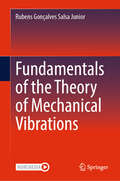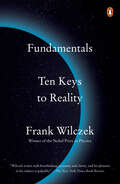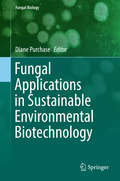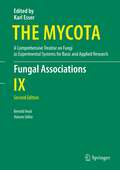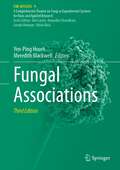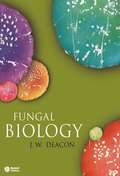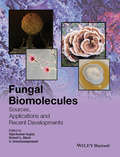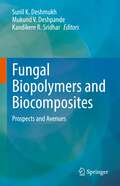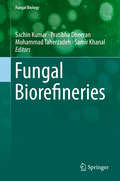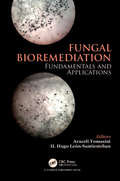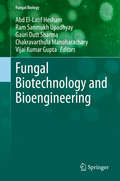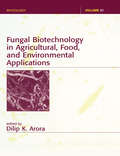- Table View
- List View
Fundamentals of the Theory of Mechanical Vibrations
by Rubens Gonçalves Salsa JuniorThis book presents the fundamental concepts of modeling and analysis of vibrations in mechanical systems with one or more degrees of freedom. The presentation of classic topics is enriched by discussions on equilibrium, stability, and the linearization of the equations of motion. Practical examples throughout the text illustrate the applicability of the theory and explore the physics behind the equations. This book includes various Matlab codes, which allow readers to modify parameters and investigate the behavior of a wide range of mechanical systems. Furthermore, it is demonstrated how some of the mechanical systems studied can be constructed using ordinary materials, enabling readers to compare the theoretical results predicted by the mathematical models with the actual observed behavior.
Fundamentals of the Theory of Metals
by A. A. AbrikosovThis comprehensive primer by a Nobel Physicist covers the electronic spectra of metals, electrical and thermal conductivities, galvanomagnetic and thermoelectrical phenomena, the behavior of metals in high-frequency fields, sound absorption, and Fermi-liquid phenomena. Addressing in detail all aspects of the energy spectra of electrons in metals and the theory of superconductivity, it continues to be a valuable resource for the field almost thirty years after its initial publication. Targeted at undergraduate students majoring in physics as well as graduate and postgraduate students, research workers, and teachers, this is an essential reference on the topic of electromagnetism and superconductivity in metals. No special knowledge of metals beyond a course in general physics is needed, although the author does presume a knowledge of quantum mechanics and quantum statistics.
Fundamentals of van der Waals and Casimir Interactions (Springer Series on Atomic, Optical, and Plasma Physics #102)
by Bo E. SerneliusThis book presents a self-contained derivation of van der Waals and Casimir type dispersion forces, covering the interactions between two atoms but also between microscopic, mesoscopic, and macroscopic objects of various shapes and materials. It also presents detailed and general prescriptions for finding the normal modes and the interactions in layered systems of planar, spherical and cylindrical types, with two-dimensional sheets, such as graphene incorporated in the formalism. A detailed derivation of the van der Waals force and Casimir-Polder force between two polarizable atoms serves as the starting point for the discussion of forces: Dispersion forces, of van der Waals and Casimir type, act on bodies of all size, from atoms up to macroscopic objects. The smaller the object the more these forces dominate and as a result they play a key role in modern nanotechnology through effects such as stiction. They show up in almost all fields of science, including physics, chemistry, biology, medicine, and even cosmology. Written by a condensed matter physicist in the language of condensed matter physics, the book shows readers how to obtain the electromagnetic normal modes, which for metallic systems, is especially useful in the field of plasmonics.
Fundamentals: Ten Keys to Reality
by Frank WilczekOne of our great contemporary scientists reveals the ten profound insights that illuminate what everyone should know about the physical worldIn Fundamentals, Nobel laureate Frank Wilczek offers the reader a simple yet profound exploration of reality based on the deep revelations of modern science. With clarity and an infectious sense of joy, he guides us through the essential concepts that form our understanding of what the world is and how it works. Through these pages, we come to see our reality in a new way--bigger, fuller, and stranger than it looked before.Synthesizing basic questions, facts, and dazzling speculations, Wilczek investigates the ideas that form our understanding of the universe: time, space, matter, energy, complexity, and complementarity. He excavates the history of fundamental science, exploring what we know and how we know it, while journeying to the horizons of the scientific world to give us a glimpse of what we may soon discover. Brilliant, lucid, and accessible, this celebration of human ingenuity and imagination will expand your world and your mind.
Fungal Applications in Sustainable Environmental Biotechnology
by Diane PurchaseFungi are distinct eukaryotic organisms renowned for their remarkable biodiversity and extensive range of habitats. Many fungal species have long been exploited for food and medicines. This volume considers other important applications of fungal biotechnology especially in an environmental context, showcasing the essential contributions of these amazingly versatile organisms. It explores how fungi offer sustainable solutions to tackle various environmental concerns. Written by eminent experts in their fields, this work presents a broad array of current advances and future prospects in fungal environmental biotechnology and discusses their limitations and potential. The book is organized in five parts, each addressing a theme of the UN Sustainable Development Goals (SDG): strengthen food security (Zero Hunger), wastewater treatment (Clean Water & Sanitation), pollution reduction (Life on Land), biofuel production (Affordable & Clean Energy) and biosynthesis of novel biomolecules (Responsible Consumption & Production).
Fungal Associations
by Bertold HockThis new edition of Fungal Associations focuses on mycorrhizas, lichens and fungal-bacterial symbioses. It has been completely revised, updated and expanded. Renowned experts present thorough reviews and discuss the most recent findings on molecular interactions between fungi and plants or bacteria that lead to morphological alterations and novel properties in the symbionts. New insights into the beneficial impact of fungal associations on ecosystem health are provided and documented with striking examples.
Fungal Associations (The Mycota #9)
by Meredith Blackwell Yen-Ping HsuehFungi are associated with a wide variety of other organisms. Ecologist Peter Price has said, “mutualism facilitates adaptive radiation,” and many biologists attribute Earth’s great fungal diversity to such associations. The 3rd edition of The Mycota, Vol. 9: Fungal Associations, has been revised to provide entirely new coverage of fungi and associated organisms in fourteen informative discussions that take advantage of today’s large public databases and modern molecular and data analysis methods. The editors have a keen interest in fungal associations in their own research, and their perspectives from different generations have resulted in an interesting treatment of the subject. Fungal Associations includes updates of classic topics, but also introduces less frequently discussed associations and broader reflections on the nature of fungi and their associates. The volume begins with a look at more than a billion years of fungal evolution and associations through the lens of immunology. Can fungi involved in obligate symbioses be cultivated apart from the host? Genomes help to answer the question. The ultimate intimacy between fungi and certain unrelated organisms has resulted in DNA exchange that can be traced in extant genomes. Fungi and bacteria use volatile compounds to lure participants into interactions. Some viruses modify the phenotype of their fungal hosts and affect host fitness. Details of interactions between classical examples of fungus—plant symbioses (lichens, several types of mycorrhizae, and toxic endophytes) benefit from advanced microscopic and molecular techniques.Discussions of fungi associated with insects (entomopathogens, a Drosophila model to study entomopathogens), nematode-trapping fungi and their prey, and a group of termite-associated fungi that produce secondary metabolites with potential uses as pharmaceuticals, complete the volume. Fungal Associations is a well-illustrated, thought-provoking resource for specialists and generalists, including researchers, lecturers, and students interested in ecology, evolution, microbiology, and mycology. The volume would be an excellent text for a seminar course for advanced undergraduate or graduate students.
Fungal Biofilms (Springer Series on Biofilms #15)
by Gordon Ramage David AndesThis book provides a comprehensive and up-to-date compendium of critical information for those working in the field of fungal biofilms, and those entering the field. The WHO has published a list of critical high-priority fungal pathogens, many of which are capable of forming biofilms. The editors have brought together a team of world experts to impart their knowledge of specific elements of fungal biofilm biology and their clinical underpinning. The book covers critical areas of state-of-the-art research that are shaping the direction of travel within the biofilm research community. It focuses on the basic biology of how biofilms are formed and controlled, through applied areas of research where we can effectively manage these complex infections.
Fungal Biology
by J. W. DeaconVisit the accompanying website from the author at www.blackwellpublishing.com/deacon. Fungal Biology is the fully updated new edition of this undergraduate text, covering all major areas of fungal biology and providing insights into many topical areas. Provides insights into many topical areas such as fungal ultrastructure and the mechanisms of fungal growth, important fungal metabolites and the molecular techniques used to study fungal populations. Focuses on the interactions of fungi that form the basis for developing biological control agents, with several commercial examples of the control of insect pests and plant diseases. Emphasises the functional biology of fungi, with examples from recent research. Includes a clear illustrative account of the features and significance of the main fungal groups.
Fungal Biology in the Origin and Emergence of Life
by David MooreThe rhythm of life on Earth includes several strong themes contributed by Kingdom Fungi. So why are fungi ignored when theorists ponder the origin of life? Casting aside common theories that life originated in an oceanic primeval soup, in a deep, hot place, or even a warm little pond, this is a mycological perspective on the emergence of life on Earth. The author traces the crucial role played by the first biofilms - products of aerosols, storms, volcanic plumes and rainout from a turbulent atmosphere - which formed in volcanic caves 4 billion years ago. Moore describes how these biofilms contributed to the formation of the first prokaryotic cells, and later, unicellular stem eukaryotes, highlighting the role of the fungal grade of organisation in the evolution of higher organisms. Based on the latest research, this is a unique account of the origin of life and its evolutionary diversity to the present day.
Fungal Biomolecules: Sources, Applications and Recent Developments
by Vijai Kumar Gupta Prof. Robert L. Mach Prof. S. SreenivasaprasadFungi have an integral role to play in the development of the biotechnology and biomedical sectors. The fields of chemical engineering, Agri-food,Biochemical, pharmaceuticals, diagnostics and medical device development allemploy fungal products, with fungal biomolecules currently used in a wide range of applications, ranging from drug development to food technology and agricultural biotechnology. Understanding the biology of different fungi in diverse ecosystems, as well as their biotropic interactions with other microorganisms, animals and plants, is essential to underpin effective and innovative technological developments.Fungal Biomolecules is a keystone reference, integrating branches of fungal product research into a comprehensive volume of interdisciplinary research. As such, it:reflects state-of-the-art research and current emerging issues in fungal biology and biotechnology reviews the methods and experimental work used to investigate different aspects of fungal biomolecules provides examples of the diverse applications of fungal biomolecules in the areas of food, health and the environmentis edited by an experienced team, with contributions from international specialists This book is an invaluable resource for industry-based researchers, academic institutions and professionalsworking in the area of fungal biology and associated biomolecules for their applications in food technology, microbial and biochemical process, biotechnology, natural products, drug development and agriculture.
Fungal Biopolymers and Biocomposites: Prospects and Avenues
by Sunil K. Deshmukh Mukund V. Deshpande Kandikere R. SridharThe book covers an overview of fungal polymers, fungal mycelial biomass, and their applications besides providing a detailed account of various opportunities. This book also includes information on developments in mycotechnology related to fashion, furnishing, construction, packaging, mycelial-based bricks, construction binder, cementing materials, and so on. Other aspects include the value of chitin, chitosan, hydrophobins, lignocellulosic composites, oil recovery, biosurfactants and bioemulsifiers, nanofibers from pullulan, exopolymeric substances, bioresins, and biocomposites. Additional topics covered in the book include self-healing fungal concrete (which could help to build repairs) and recipe to inhibit fruit body formation, for living fungal biomaterial manufacture. There is no comprehensive book other than – some reviews, which addressed very brief historical developments and preliminary aspects of fungal biopolymers. Written by experts in their field from countries like Australia, India, USA, Germany, Turkey, Philippines, Oman, Belgium, Italy, Egypt, Brazil, and the United Kingdom, the chapters discuss at length applications of filamentous fungi in sustainable industrial pursuits and industrial developments with environmental safety. This book will be useful for students, teachers, researchers, and scientists in botany, microbiology, life sciences, biotechnology, agriculture and, industries that extensively use fungi for the production of value-added products.
Fungal Biorefineries (Fungal Biology)
by Samir Khanal Sachin Kumar Pratibha Dheeran Mohammad TaherzadehThis book covers the applications of fungi used in biorefinery technology. As a great many different varieties of fungal species are available, the text focuses on the various applications of fungi for production of useful products including organic acids (lactic, citric, fumaric); hydrolytic enzymes (amylase, cellulases, xylanases, ligninases, lipases, pectinases, proteases); advanced biofuels (ethanol, single cell oils); polyols (xylitol); single cell protein (animal feed); secondary metabolites; and much more.
Fungal Bioremediation: Fundamentals and Applications
by Araceli Tomasini Campocosio Hector Hugo SantiestebanThis book highlights the role fungi play in bioremediation, as well as the mechanisms and enzymes involved in this process. It covers the application of bioremediation with fungi in polluted sites and gives a wide overview of the main applications of remediation, such as degradation of xenobiotics, gaseous pollutants, and metal reduction. The book explains the degradation of emergent pollutants and radioactive compounds by fungi, which is relevant to the current pollution problems that have been studied over the last few decades. The book also describes the most advanced techniques and tools that are currently used in this field of study.
Fungal Biotechnology and Bioengineering (Fungal Biology)
by Vijai Kumar Gupta Gauri Dutt Sharma Chakravarthula Manoharachary Abd El-Latif Hesham Ram Sanmukh UpadhyayFungi are eukaryotic microorganisms that include both unicellular and multicellular species. They have a worldwide distribution and a wide range of applications in diverse sectors, from environmental, food and medicine to biotechnological innovations. Fungal biochemical genetics involves the study of the relationships between genome, proteome and metabolome, and the underlying molecular processes in both native and bioengineered fungi. This book provides a valuable resource on the challenges and potential of fungal biotechnology and related bioengineering and functional diversity for various industrial applications in the food, environmental, bioenergy and biorefining, and the biopharma sectors. In comparison to previous and related publications in the area of applied myco-biotech-engineering, this book bridges a knowledge gap in the areas related to prospects and investment as well as intellectual and technical issues. This book also provides information on recent commercial and economic interests in the area by juxtaposing the developments achieved in recent worldwide research and its many challenges.
Fungal Biotechnology in Agricultural, Food, and Environmental Applications (Mycology Ser. #Vol. 21)
by Dilip K. AroraContributions from 80 world-renowned authorities representing a broad international background lend Fungal Biotechnology in Agricultural, Food, and Environmental Applicationsfirst-class information on the biotechnological potential of entomopathogenic fungi and ergot alkaloids, applications of Trichoderma in disease control, and the d
Fungal Biotechnology: Advancements in Drug Discovery, Healthcare, and Environmental Solutions
by Arshad Farid Gagan PreetThis book presents diverse applications of fungi in medical, pharmaceutical, and environmental sciences. It discusses the intricate processes involved in fungal metabolite production, bioactive compound discovery, and genetic engineering, highlighting their critical roles in addressing global challenges, such as chronic diseases, drug development, and environmental sustainability. This book examines the growing importance of fungi in the biopharmaceutical industry, including their use in immunotherapy, vaccine development, and precision medicine, while also exploring the novel applications of fungal nanobiotechnology in drug delivery systems. The chapters explore challenges in antifungal drug development and food safety, particularly regarding mycotoxins, and offer practical insights into diagnostic techniques for fungal infections. This book also addresses the global regulatory standards for fungal products and the ethical considerations surrounding the advancement of fungal biotechnology.
Fungal Biotechnology: Prospects and Avenues (Progress in Mycological Research)
by Sunil K. DeshmukhTraditional studies in mycology mainly deal with damage caused by fungi, for instance, diseases of plants, animal ailments, air-borne pathogens, decomposition of wood and production of mycotoxins in food. Applied mycology focuses on the fermentation of foods (flours, bakery products, cheese and others) and production of fermented products (wine, beer and spirit). Further value-added approaches show the significance of fungi in the production of bioactive metabolites and pharmaceuticals used in the treatment of human diseases, including cancer, and plant diseases (e.g. pest control). Due to a dependence on fossil resources, production of bio-renewable merchandise gained importance and fungi serve as potential biological agents in sustaining global economy. Recent developments in mycology revealed their significance in the fields of advanced research, in particular building materials, packaging resources, electronic devises and leather-like goods. In addition, fungi possess several qualities to degrade non-biodegradable compounds in the ecosystem and assist in sustainable waste bioremediation. This book covers the current biotechnological advances and bio-prospect potential of fungi. Fungal biopolymers possess various applications, including prebiotics, therapeutics, immunoceuticals, drug-discovery and drug-delivery. Fungal bioactive metabolites have several implications beyond antibiotics, such as volatiles, biofuels, nematicides and pigments. They also serve as prospective tools in the production of nanoparticles of medicinal, nutritional and industrial significance. In view of environmental protection, fungal activity and products aid in bioremediation via degradation of xenobiotics and solid wastes. Fungi can produce agriculturally compatible metabolites to enhance plant production. Knowledge on fungal genomics facilitates the gene manipulation towards biotechnological applications (disease diagnosis, pathogen detection, gene expression and mutualistic interactions). This book addresses the application of fungi in different areas and serves as a potential knowledge bank for graduates, post-graduates and researchers contemplating fungal applications.
Fungal Cell Wall: Structure, Synthesis, and Assembly, Second Edition (Mycology)
by José Ruiz-HerreraFungal Cell Wall: Structure, Synthesis, and Assembly, Second Edition is a compendium of information on the chemical structure, synthesis, and organization of the cell wall of fungi. Reviewing the past 20 years of research in the field, it discusses experimental evidence that demonstrates the role of the cell wall in the growth, development, morphog
Fungal Cellulolytic Enzymes: Microbial Production And Application
by Xu Fang Yinbo QuThe book provides an overview of the current knowledge on cellulolytic enzymes and their applications. It summarizes the mechanisms of synthesis and hydrolysis of cellulolytic enzymes, industrial fungal strains, genetic engineering of fungal strains and application of cellulolytic enzymes. This book will be a useful reference for researchers and bioengineering experts engaged in lignocelluloses biodegradation, biomass utilization, enzyme production and fungal molecular biology.
Fungal Diagnostics
by Barry Glynn Louise O'ConnorInvasive fungal infections are a significant cause of morbidity and mortality. Over the past decade there has been a concerted effort to develop reliable methods for the detection of such infections. In Fungal Diagnostics: Methods and Protocols, expert researchers in the field detail the introduction of new technology into a diagnostic setting include ease of use, and rapid turnaround time without compromising sensitivity and specificity. Focusing specifically on fungal detection in clinical settings, fungal diagnostics including, environmental testing, agriculture and food production and veterinary diagnostics. Written in the highly successful Methods in Molecular BiologyTM series format, chapters include introductions to their respective topics, lists of the necessary materials and reagents, step-by-step, readily reproducible laboratory protocols, and key tips on troubleshooting and avoiding known pitfalls. Authoritative and practical, Fungal Diagnostics: Methods and Protocols seeks to aid scientists into the further study of diagnostic and detection of fungi.
Fungal Diseases in Animals: From Infections to Prevention (Fungal Biology)
by Arti Gupta Nagendra Pratap SinghThe importance of fungal infections in both human and animals has increased over the last few decades. This book presents an overview of the different categories of fungal infections that can be encountered in animals (including lower vertebrates) originating from environmental sources with or without transmission to humans. In addition, the endemic infections with indirect transmission from the environment, the zoophilic fungal pathogens with near-direct transmission, the zoonotic fungi that can be directly transmitted from animals to humans, mycotoxicoses and antifungal resistance in animals will also be discussed. This book includes case studies and reviews the current state of knowledge on the mechanism of fungal attraction, recognition, infection, extracellular hydrolytic enzymes and pathogenesis of nematophagous fungi. The book also covers diagnostics, fungal formulations, as well as prevention methods. It discusses strategies to access the fungal pathogen groups, metagenomic analyses, genomics, secretomics, metabolomics, proteomics and transcriptomics. In addition, pathogen description, understanding, distribution and recent research results are provided.
Fungal Endophytes Volume I: Biodiversity and Bioactive Materials
by Kamel A. Abd-Elsalam Synan F. AbuQamarThis book explores the ecology and evolutionary dynamics of fungi. It focuses on identifying new metabolites extracted from endophytic fungi through genetic methods and bioassay-guided isolation. Detailed procedures for producing fungal endophyte metabolites for commercial use are also discussed. This book covers the diverse traits of fungal endophytes and their interactions with host plants, providing tactical insights into how these organisms can be utilized to their full potential in pharmaceutical, agricultural and industrial applications. This interdisciplinary reference is suitable for students and researchers in fields such as materials science, biology, plant science, microbiology, plant physiology and biotechnology. It is also useful for agri-food environmental scientists and agrochemical companies. In addition, the book offers valuable information for industrial scientists working on the synthesis and application of fungal secondary metabolites in plant science.
Fungal Endophytes Volume II: Applications in Agroecosystems and Plant Protection
by Kamel A. Abd-Elsalam Amr H. HashemThis book explores applications of endophytic fungi in agriculture and plant protection. It provides insights into the potential of these fungi in developing environmentally friendly and sustainable agricultural techniques. This book discusses the use of endophytic fungi as biocontrol agents against plant infections and stressors. It is targeted at farmers, plant pathologists, agricultural researchers, biotechnology experts, and students of biology and agronomy who are interested in learning more about the expanding applications of fungal endophytes in agriculture and plant health. The book examines the role of endophytes and their bioactive metabolites in agricultural yield, plant growth promotion, and plant defence against stress and disease.
Fungal Extracellular Vesicles: Biological Roles (Current Topics in Microbiology and Immunology #432)
by Marcio Rodrigues Guilhem JanbonThis book provides an in-depth overview on the manifold functions of fungal extracellular vesicles (EV) which span from cell-to-cell communication, pathogenicity and stimulation of host’s immunity to export of hundreds of biomolecules. The book summarizes the present knowledge on the impact of extracellular vesicles on fungal biology. Extracellular vesicles participate in fundamental biological processes in all living cells but only during the last 15 years the production and functions of EVs were identified and studied in fungal species too. Up to date more than 50 independent studies have shown that extracellular vesicles are produced by at least 20 fungal species. The book addresses researchers and advanced students in Microbiology, Mycology and Biotechnology.
